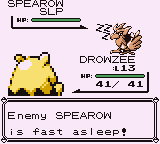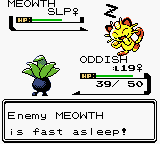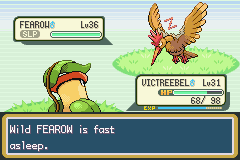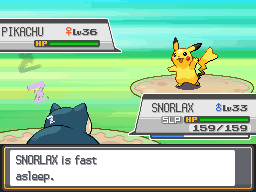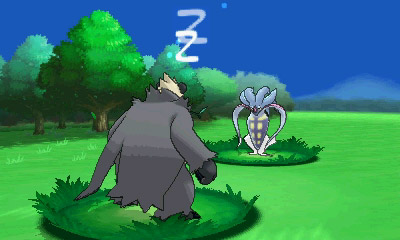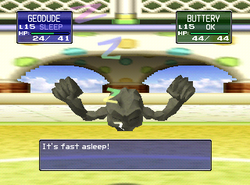Sleep (status condition): Difference between revisions
No edit summary |
8BitRevenge (talk | contribs) (→Trivia) |
||
| Line 242: | Line 242: | ||
==Trivia== | ==Trivia== | ||
* Sleep is the status condition with the most moves that always cause it when they hit. | * Sleep is the status condition with the most moves that always cause it when they hit. | ||
* Not counting, fainted, sleep is the only status condition not technically associated with a certain type. Even so, grass and normal are the two most common types it is affiliated with. | |||
==References== | ==References== | ||
Revision as of 19:46, 28 November 2013

The sleep condition (SLP) (Japanese: ねむり Sleeping) causes a Pokémon to be unable to make a move. In Generation V, Pokémon close their eyes when they are asleep, and their movement slows down.
Effect
Sleep causes a Pokémon to be unable to make a move for an indeterminate number of moves. The specifics vary between generations.
Generation I
Sleep lasts for a randomly chosen duration of 1 to 7 turns (1 to 3 in Stadium). A Pokémon cannot move on the turn it wakes up. A Pokémon can inflict self-induced sleep using the move Rest, which will restore all of the Pokémon's health and remove any other non-volatile status condition. A disobedient Pokémon may also nap during battle.
Sleeping Pokémon are vulnerable to Dream Eater.
Generation II onwards
A Pokémon can move on the turn it woke up.
In addition to Dream Eater, sleeping Pokémon are now vulnerable to Nightmare.
Roaming Pokémon do not flee while asleep.
Generation III
Sleep lasts for a random duration from 1 to 6 turns.
Roaming Pokémon now attempt to flee in the usual way while asleep.
Generation IV
Sleep lasts for a random duration from 1 to 4 turns.
In the Japanese version of Diamond and Pearl, the minimum and maximum sleep count are 1 turn higher.[1]
In addition to Dream Eater and Nightmare, sleeping Pokémon are now vulnerable to Darkrai's Ability, Bad Dreams.
Generation V
Sleep lasts for a random duration from 1 to 3 turns. In addition, a Pokémon's sleep counter is reset to its original amount when switched out; this also applies for self-induced sleep. Also in Generation V, most Pokémon close their eyes while sleeping, and their animation moves more slowly as well.
Generation VI
A Pokémon's sleep counter no longer resets to its original amount when switched out.
Appearance
Causes
Moves
|
Other causes
The Ability Effect Spore can cause sleep, poison, or paralysis. A disobedient outsider Pokémon may take a nap instead of obeying commands.
Prevention and curing
Items
Being put to sleep can be cured with the use of an Awakening or a Chesto Berry (Mint Berry in Generation II). In addition, like all other major status conditions, it can be cured by the items Full Heal, Lava Cookie, Full Restore, Old Gateau, Heal Powder, Lum Berry, Casteliacone, and Sacred Ash. In Generation I games and its remakes, Poké Flute can be reused indefinitely, while Blue Flute can be used in Generation III and IV games.
Moves
Heal Bell and Aromatherapy also removes it from all Pokémon in the party. Safeguard will prevent the user's team from being afflicted by any status condition for five turns and a Pokémon behind a substitute cannot be put to sleep (other than using Rest). Wake-Up Slap's base power increases when used on sleeping targets, but wakes them up. Pokémon hit with Worry Seed have their Ability temporarily changed to Insomnia, effectively preventing them from sleeping, and waking already asleep targets. It can target both friends and foes, but not the user, or Pokémon with the Abilities Truant or Multitype. No Pokémon can sleep while one of them is using the continuous move Uproar.
Abilities
Pokémon with the Abilities Vital Spirit and Insomnia or active allies of Pokémon with the Ability Sweet Veil cannot be put to sleep. In a similar vein, Pokémon with the Ability Leaf Guard cannot be put to sleep if the weather is intensely sunny. A Pokémon with Natural Cure will be cured upon switching out, one with the Hydration Ability will be cured while it is raining (even if self-afflicted), one with Early Bird halves the amount of turns it is asleep, one with Shed Skin has a 1/3 chance of being cured every turn. An ally with Healer has a 1/3 chance of curing an ally's condition every turn during double and Triple Battles, while an ally with Sweet Veil prevents allies from sleeping altogether.
Miscellaneous
In Pokémon Colosseum and XD, the Call option replaces the usual Run option, as most battles in Orre are Trainer battles. The Call option is mainly used to snap Shadow Pokémon out of Hyper Mode or Reverse Mode, but it can also awaken sleeping Pokémon.
Benefits
The moves Snore and Sleep Talk can only be used while asleep. Pokémon with Guts and Quick Feet will have their Attack or Speed boosted respectively while they are asleep, but must use the aforementioned moves to completely reap their benefits. On the other hand, Pokémon with the Ability Marvel Scale will have their Defense boosted, and do not need to use these moves.
In the spin-off games
Pokémon Conquest
Sleep prevents a Pokémon from taking any action during their turn, but their Warrior may still use their Warrior Skill or item. Sleep can be cured through certain Warrior Skills, items, or by ending a Pokémon's turn in a hot spring or a water bucket. There is also a chance for sleeping Pokémon to wake up at the start of their turn.
Sleep can be inflicted by abilities and attacks, but compared to other status conditions, attacks and abilities that inflict sleep are rare: there is only one attack to inflict Sleep, Munna's Hypnosis, and only three abilities to inflict sleep, one of which is exclusive to Musharna. Sleep can be inflicted on the player's team by Yoshimoto's exclusive Warrior Skill Grace, which fully heals the player's army then puts them to sleep.
Mystery Dungeon
- Main article: Sleep-related conditions in Mystery Dungeon
In the Pokémon Mystery Dungeon series, there are several different varieties on the sleeping condition. The standard, Asleep, functions similarly to how Sleep does in the main games. When a Pokémon is asleep, he or she cannot act for 3 to 6 turns. The sleeping Pokémon can use Snore and Sleep Talk, and is vulnerable to Dream Eater and Bad Dreams.
Rest in Mystery Dungeon is turned into a move that causes a variety of Asleep on the user, named Napping. Napping is similar to Asleep, but when the user wakes, all their negative status conditions will be gone.
Nightmare in Mystery Dungeon is turned into a move that causes a variation of Asleep, named after itself, although it can override a Pokémon that's already Asleep or Napping. When a Pokémon is inflicted with Nightmare, he or she cannot act for 4 to 7 turns, and takes 8 HP of damage when he or she awakens.
Other sleep aliments include Yawning, which causes Asleep after 3 turns, and Sleepless, which prevent the previous four conditions from occurring for 11 to 12 turns. Like in the main games, Sleeping can be cured early using a Chesto Berry.
In the anime

Sleeping is a status condition that has been present since the early days of the anime. When used in battle, it often forces the afflicted Pokémon to be recalled. Uses of sleep in major episodes and movies include:
- Sleeping was first used in battle in Pokémon! I Choose You! by a Trainer's Gengar in the Pokémon League. Gengar's Hypnosis put the opponent's Nidorino to sleep, forcing the Nidorino's Trainer to switch.
- In Challenge of the Samurai, Ash's Butterfree used Sleep Powder to calm a swarm of Beedrill. He later tried to use Sleep Powder on Misty's Staryu in The Water Flowers of Cerulean City, but Staryu avoided its effects by diving underwater.
- In Hypno's Naptime, the abuse of Hypno's Hypnosis had been causing the Pokémon of HopHopHop Town to fall asleep without warning. It put the town's children, as well as Misty under a trance, in which they would run away to a pond and start acting like Pokémon.
- In The Ninja Poké-Showdown, Koga's Venomoth used Sleep Powder on Ash's Pidgeotto during their Gym battle, forcing Ash to switch.
- A Jigglypuff that followed Ash and his friends almost always used Sing whenever it appeared. When it discovered that its "audience" slept through its song, the balloon Pokémon doodled on the sleeping Pokémon, and people, before leaving in a huff. However, its songs have still helped out Ash and the people he has met from time to time. In its debut episode, its song helped the cranky people of Neon Town finally fall asleep, after which, they woke up much more agreeable and friendly. In the following episode, Jigglypuff's song was able to put back to sleep the angry ancient Pokémon that slept there.
- In The Ancient Puzzle of Pokémopolis, a giant Jigglypuff puts giant battling Alakazam and Gengar asleep with Sing.
- In Friend and Foe Alike, Ritchie's Butterfree, Happy, used Sleep Powder on Ash's Squirtle during their league battle. Squirtle, already tired from a previous attack by Jessie, James, and Meowth, was declared unable to battle.
- In Tracey Gets Bugged, Tracey's Venonat used Sleep Powder to put a wild Scyther asleep so it could be caught and taken to a Pokémon Center.
- In Charizard Chills, Tad's Poliwrath put Ash's Pikachu asleep with Hypnosis.
- In Ignorance is Blissey, multiple Nurse Joy's Chansey put various Pokémon (plus Jessie) asleep with Sing at the Pokémon Nurse School.
- In Ariados, Amigos, Aya's Venonat put itself asleep with Rest during a battle with Jessie's Arbok.
- In As Cold as Pryce, Pryce had his Piloswine use Rest to put itself to sleep.
- In Jirachi: Wish Maker, Butler used his Kirlia's Hypnosis to put Absol to sleep.
- In Going, Going, Yawn, Flannery's Meg put Ash's Corphish asleep with Yawn.
- In Going for a Spinda, Claire's Spinda put Team Rocket asleep with Hypnosis.
- In The Garden of Eatin', a wild Snorlax used Yawn to put various people and Pokémon asleep, including Ash and his friends, while using Rest to heal itself. This move was finally countered when Marcel used a Vigoroth against Snorlax. With its Vital Spirit protecting it from sleep, Vigoroth was able to defeat Snorlax, allowing Marcel to catch it.
- In Rough, Tough Jigglypuff, a wild Jigglypuff put Ash, his friends, Team Rocket, Mitch Mitchum, and several Pokémon, including Ash's Pikachu, asleep with its Sing.
- In Wheel of Frontier, Ash's Snorlax used Rest and went to sleep while being frozen by Greta's Medicham's Ice Punch.
- In Harley Rides Again, May's Munchlax's Metronome landed on Rest during the Appeals Round of the Wisteria Contest. She was able to wake Munchlax up by throwing it a Pokéblock.
- In Channeling the Battle Zone!, Solidad used her Slowbro's Yawn to put May's Combusken asleep.
- In Pace - The Final Frontier!, Brandon's Regice went to sleep twice by using Rest in order to recover from the damage taken while battling with Ash's Pikachu.
- A wild Hippopotas, which appeared in Mass Hip-Po-Sis! and Sleight of Sand!, used Yawn several times, putting several characters, including Ash and Jessie, asleep a couple of times.
- In The Rise of Darkrai, Darkrai used its Dark Void in order to warn the people of Alamos Town about the coming attack of Dialga and Palkia. Unfortunately, the Bad Dreams that it caused led Baron Alberto to see Darkrai as a threat.
- In Lost Leader Strategy!, Reggie's Bibarel put Ash's Turtwig to sleep using Secret Power.
- In Playing the Leveling Field!, Fantina's Drifloon, later Drifblim, used Hypnosis to put Ash's Buizel, Chimchar and Pikachu asleep during Ash's unofficial battle with her. Pikachu and Buizel got affected by Drifblim's Hypnosis again during Ash's Gym battle with Fantina in Shield with a Twist!.
- In Battling The Generation Gap!, Lila's Delcatty put Dawn's Ambipom to sleep using Sing.
- In League Unleashed!, Nando's Kricketune used Sing to put Ash's Heracross to sleep. However, Heracross was able to counter it with Sleep Talk.
- In Zoroark: Master of Illusions, Tammy's Tangrowth used Sleep Powder to put Zorua asleep.
- In The Semi-Final Frontier!, Tobias's Darkrai used a combination of Dark Void and Dream Eater against Ash's Heracross, quickly knocking it out. Darkrai also put Sceptile to sleep, but it managed to wake up just in time to take it out with Leaf Blade.
In the manga

Pokémon Adventures
In Pokémon Adventures, every move that can induce Pokémon to sleep have caused this status condition.
The Electric Tale of Pikachu
In The Electric Tale of Pikachu, in Play Misty for Me, Ash's Metapod evolves into Butterfree during his Gym battle with Misty. Butterfree uses Sleep Powder to stop Misty's vicious Gyarados, which is the decisive move Ash needs to take back his stolen hat and win the Cascade Badge.
Phantom Thief Pokémon 7
In Phantom Thief Pokémon 7, the titular Phantom Thief, Hiori, uses his Tangrowth's Sleep Powder to sneak past the Galactic Grunts that guard Team Galactic's base.
In the TCG
In the Trading Card Game, Sleep, called Asleep, is one of the five Special Conditions along with Poisoned, Burned, Confused, and Paralyzed. If a Pokémon is Asleep, it cannot attack or retreat by itself. It must also be turned to the left. After each turn, if a player's Pokémon is Asleep, the player must flip a coin: if heads, the Asleep Pokémon "wakes up" and is no longer affected by the Special Condition. However, if the coin lands on tails, the Pokémon is still asleep. Unlike the Pokémon games, a Pokémon can be afflicted with more than one Special Condition at once; however, some special conditions will erase ones already present.
Trivia
- Sleep is the status condition with the most moves that always cause it when they hit.
- Not counting, fainted, sleep is the only status condition not technically associated with a certain type. Even so, grass and normal are the two most common types it is affiliated with.
References
| Status conditions | |||
|---|---|---|---|
| BURN | FREEZE | PARALYSIS | POISON |
| SLEEP | CONFUSION | FLINCH | FAINTING |

|
This game mechanic article is part of Project Games, a Bulbapedia project that aims to write comprehensive articles on the Pokémon games. |
